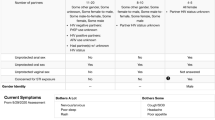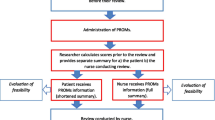Abstract
Introduction
Systematic collection of patient-reported outcome measures (PROMs) during ambulatory clinic visits can enhance communication between patient and provider, and provide the ability to evaluate outcomes of care. Little is known about patient satisfaction of PROM data collection in routine clinical care. To evaluate patient reaction to the routine collection of PROMs in the ambulatory setting.
Methods
Before all ambulatory clinic visits at our neurological institute, patients electronically complete health status questionnaires. We administered an 8-question patient satisfaction survey to a sample of patients seen across the institute after their clinical visit.
Results
Of 343 patients approached, 323 agreed to participate. The majority responded that the questionnaire system was easy to use, was an appropriate length, and benefited their care overall (strongly agree or agree = 92.3%, 87.6%, and 77.3%, respectively). Provider review of the PROMs with the patient during the clinic visit was associated with significantly higher positive responses to all questions, even those regarding logistical aspects of the collection process. There were significant age and race differences in response to perceived benefit: those in the Black/other race category had a markedly lower probability of viewing the process favorably with increasing age.
Conclusions
Systematic collection of PROMs via an electronic questionnaire appears to be well accepted by patients. A minority of patients did not feel the questionnaire content applied to their appointment or that the system was a beneficial feature of the clinical practice. The provider can significantly improve the patient’s perception of PROM collection and the patient–physician encounter by reviewing the questionnaire results with the patient.



Similar content being viewed by others
References
Patel RA, Klasnja P, Hartzler A, Unruh KT, Pratt W. Probing the benefits of real-time tracking during cancer care. AMIA Annu Symp Proc. 2012;2012:1340–9.
Jacobs JE, van de Lisdonk EH, Smeele I, van Weel C, Grol RP. Management of patients with asthma and COPD: monitoring quality of life and the relationship to subsequent GP interventions. Fam Pract. 2001;18(6):574–80.
Rose M, Bezjak A. Logistics of collecting patient-reported outcomes (PROs) in clinical practice: an overview and practical examples. Qual Life Res. 2009;18(1):125–36.
Basch E, Deal AM, Kris MG, Scher HI, Hudis CA, Sabbatini P, Rogak L, Bennett AV, Dueck AC, Atkinson TM, Chou JF, Dulko D, Sit L, Barz A, Novotny P, Fruscione M, Sloan JA, Schrag D. Symptom monitoring with patient-reported outcomes during routine cancer treatment: a randomized controlled trial. J Clin Oncol. 2016;34(6):557–65.
Basch E, Iasonos A, Barz A, Culkin A, Kris MG, Artz D, Fearn P, Speakman J, Farquhar R, Scher HI, McCabe M, Schrag D. Long-term toxicity monitoring via electronic patient-reported outcomes in patients receiving chemotherapy. J Clin Oncol. 2007;25(34):5374–80.
Detmar SB, Muller MJ, Schornagel JH, Wever LD, Aaronson NK. Health-related quality-of-life assessments and patient-physician communication: a randomized controlled trial. JAMA. 2002;288(23):3027–34.
Velikova G, Booth L, Smith AB, Brown PM, Lynch P, Brown JM, Selby PJ. Measuring quality of life in routine oncology practice improves communication and patient well-being: a randomized controlled trial. J Clin Oncol. 2004;22(4):714–24.
Jensen RE, Rothrock NE, DeWitt EM, Spiegel B, Tucker CA, Crane HM, Forrest CB, Patrick DL, Fredericksen R, Shulman LM, Cella D, Crane PK. The role of technical advances in the adoption and integration of patient-reported outcomes in clinical care. Med Care. 2015;53(2):153–9.
Katzan IL, Fan Y, Speck M, Morton J, Fromwiller L, Urchek J, Uchino K, Griffith SD, Modic M. Electronic stroke carepath: integrated approach to stroke care. Circ Cardiovasc Qual Outcomes. 2015;8(6 Suppl 3):S179–89.
Jensen RE, Snyder CF, Abernethy AP, Basch E, Potosky AL, Roberts AC, Loeffler DR, Reeve BB. Review of electronic patient-reported outcomes systems used in cancer clinical care. J Oncol Pract. 2014;10(4):e215–22.
Basch E, Abernethy AP. Commentary: encouraging clinicians to incorporate longitudinal patient-reported symptoms in routine clinical practice. J Oncol Pract. 2011;7(1):23–5.
Health DO. Equity and excellence: Liberating the NHS. 2010. https://www.gov.uk/government/uploads/system/uploads/attachment_data/file/213823/dh_117794.pdf. Accessed Nov 1, 2016.
Snyder CF, Herman JM, White SM, Luber BS, Blackford AL, Carducci MA, Wu AW. When using patient-reported outcomes in clinical practice, the measure matters: a randomized controlled trial. J Oncol Pract. 2014;10(5):e299–306.
Nelson EC, Landgraf JM, Hays RD, Wasson JH, Kirk JW. The functional status of patients. How can it be measured in physicians’ offices? Med Care. 1990;28(12):1111–26.
Katzan I, Speck M, Dopler C, Urchek J, Bielawski K, Dunphy C, Jehi L, Bae C, Parchman A. The knowledge program: an innovative, comprehensive electronic data capture system and warehouse. AMIA Annu Symp Proc. 2011;2011:683–92.
Brooks R. EuroQol: the current state of play. Health Policy. 1996;37(1):53–72.
Martin A, Rief W, Klaiberg A, Braehler E. Validity of the Brief Patient Health Questionnaire Mood Scale (PHQ-9) in the general population. Gen Hosp Psychiatry. 2006;28(1):71–7.
Kroenke K, Spitzer RL. The PHQ-9: a new depression diagnostic and severity measure. Psychiatr Ann. 2002;32(9):1–7.
Holm S. A simple sequentially rejective multiple test procedure. Scand J Stat. 1979;6(2):65–70.
Guidance for Industry Patient-Reported Outcome Measures: use in Medical Product Development to Support Labeling Claims. 2009. Food and Drug Administration. http://www.fda.gov/downloads/Drugs/GuidanceComplianceRegulatoryInformation/Guidances/UCM193282.pdf. Accessed Nov 1, 2016.
Centers for Medicare & Medicaid Services. 2016. Physician Quality Reporting System (PQRS). http://pqrs.cms.gov. Accessed Apr 10, 2016.
Black N. Patient reported outcome measures could help transform healthcare. BMJ. 2013;346:f167.
Gnambs T, Kaspar K. Disclosure of sensitive behaviors across self-administered survey modes: a meta-analysis. Behav Res Methods. 2015;47(4):1237–59.
Velikova G, Keding A, Harley C, Cocks K, Booth L, Smith AB, Wright P, Selby PJ, Brown JM. Patients report improvements in continuity of care when quality of life assessments are used routinely in oncology practice: secondary outcomes of a randomised controlled trial. Eur J Cancer. 2010;46(13):2381–8.
Groeneveld PW, Sonnad SS, Lee AK, Asch DA, Shea JE. Racial differences in attitudes toward innovative medical technology. J Gen Intern Med. 2006;21(6):559–63.
Roblin DW, Houston TK 2nd, Allison JJ, Joski PJ, Becker ER. Disparities in use of a personal health record in a managed care organization. J Am Med Inform Assoc. 2009;16(5):683–9.
Gordon NP, Hornbrook MC. Differences in access to and preferences for using patient portals and other ehealth technologies based on race, ethnicity, and age: a database and survey study of seniors in a large health plan. J Med Internet Res. 2016;18(3):e50.
Anglin DM, Link BG, Phelan JC. Racial differences in stigmatizing attitudes toward people with mental illness. Psychiatr Serv. 2006;57(6):857–62.
O’Mahen HA, Henshaw E, Jones JM, Flynn HA. Stigma and depression during pregnancy: does race matter? J Nerv Ment Dis. 2011;199(4):257–62.
Wagner JA, Perkins DW, Piette JD, Lipton B, Aikens JE. Racial differences in the discussion and treatment of depressive symptoms accompanying type 2 diabetes. Diabetes Res Clin Pract. 2009;86(2):111–6.
Schraufnagel TJ, Wagner AW, Miranda J, Roy-Byrne PP. Treating minority patients with depression and anxiety: what does the evidence tell us? Gen Hosp Psychiatry. 2006;28(1):27–36.
Alegria M, Chatterji P, Wells K, Cao Z, Chen CN, Takeuchi D, Jackson J, Meng XL. Disparity in depression treatment among racial and ethnic minority populations in the United States. Psychiatr Serv. 2008;59(11):1264–72.
Jimenez DE, Bartels SJ, Cardenas V, Alegria M. Stigmatizing attitudes toward mental illness among racial/ethnic older adults in primary care. Int J Geriatr Psychiatry. 2013;28(10):1061–8.
Broman CL. Race differences in the receipt of mental health services among young adults. Psychol Serv. 2012;9(1):38–48.
Hassan SJ, Weymuller EA Jr. Assessment of quality of life in head and neck cancer patients. Head Neck. 1993;15(6):485–96.
Moore F, Wolfson C, Alexandrov L, Lapierre Y. Do general and multiple sclerosis-specific quality of life instruments differ? Can J Neurol Sci. 2004;31(1):64–71.
Richter JG, Becker A, Koch T, Nixdorf M, Willers R, Monser R, Schacher B, Alten R, Specker C, Schneider M. Self-assessments of patients via Tablet PC in routine patient care: comparison with standardised paper questionnaires. Ann Rheum Dis. 2008;67(12):1739–41.
Salaffi F, Gasparini S, Ciapetti A, Gutierrez M, Grassi W. Usability of an innovative and interactive electronic system for collection of patient-reported data in axial spondyloarthritis: comparison with the traditional paper-administered format. Rheumatology (Oxford). 2013;52(11):2062–70.
Salaffi F, Di Carlo M, Carotti M, Farah S, Gutierrez M. The Psoriatic Arthritis Impact of Disease 12-item questionnaire: equivalence, reliability, validity, and feasibility of the touch-screen administration versus the paper-and-pencil version. Ther Clin Risk Manag. 2016;12:631–42.
Schefte DB, Hetland ML. An open-source, self-explanatory touch screen in routine care. Validity of filling in the Bath measures on Ankylosing Spondylitis Disease Activity Index, Function Index, the Health Assessment Questionnaire and Visual Analogue Scales in comparison with paper versions. Rheumatology (Oxford). 2010;49(1):99–104.
Trau RNC, Hartel CEJ, Hartel GF. Reaching and hearing the invisible: organizational research on invisible stigmatized groups via web surveys. Br J Manag. 2013;24(4):532–41.
Acknowledgements
Funding for this study and article processing charges were provided by the Wuliger Foundation. We would like to thank providers in the Neurological Institute for their active participation in the Knowledge Program and unwavering dedication to optimizing patient care. We thank Cassandra Talerico, PhD, a salaried employee of the Cleveland Clinic, who provided editorial advice. Irene Katzan, Cheryl Dunphy and John Urchek participated in the study design. Cheryl Dunphy and Jesse Schuschu implemented the survey. Nicholas Thompson performed the statistical analysis. Pablo Recinos and Irene Katzan drafted the initial version of the manuscript; all authors participated in critical review and revision of the manuscript. Irene Katzan is the overall guarantor of the data and contents of the manuscript. All named authors meet the International Committee of Medical Journal Editors (ICMJE) criteria for authorship for this manuscript, take responsibility for the integrity of the work as a whole, and have given final approval for the version to be published.
Disclosures
Nicolas Thompson has received grant support from Novartis, Inc for research unrelated to this manuscript. Pablo F. Recinos, Cheryl J. Dunphy, Jesse Schuschu, John L. Urchek III and Irene L. Katzan have nothing to disclose.
Compliance with Ethics Guidelines
All procedures performed in studies involving human participants were in accordance with the ethical standards of the institutional and/or national research committee and with the 1964 Helsinki declaration and its later amendments or comparable ethical standards. Verbal informed consent was obtained from all participants included in the study.
Data Availability
The datasets during and/or analyzed during the current study are available from the corresponding author on reasonable request.
Author information
Authors and Affiliations
Corresponding author
Additional information
Enhanced content
To view enhanced content for this article go to http://www.medengine.com/Redeem/E337F0607D26A270.
Electronic supplementary material
Below is the link to the electronic supplementary material.
Rights and permissions
About this article
Cite this article
Recinos, P.F., Dunphy, C.J., Thompson, N. et al. Patient Satisfaction with Collection of Patient-Reported Outcome Measures in Routine Care. Adv Ther 34, 452–465 (2017). https://doi.org/10.1007/s12325-016-0463-x
Received:
Published:
Issue Date:
DOI: https://doi.org/10.1007/s12325-016-0463-x




